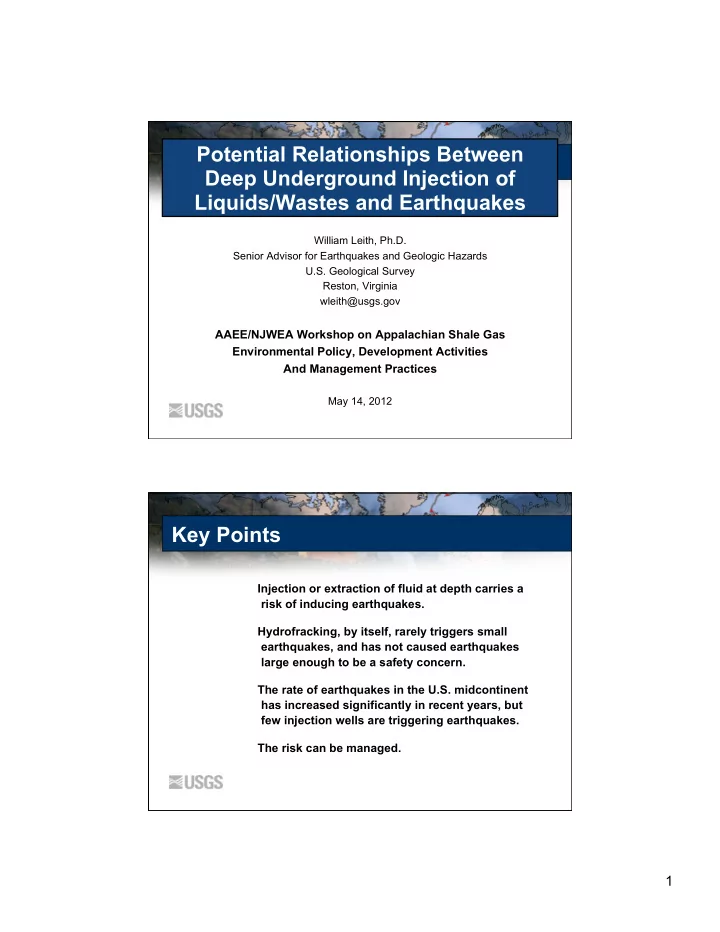

Potential Relationships Between Deep Underground Injection of Liquids/Wastes and Earthquakes William Leith, Ph.D. Senior Advisor for Earthquakes and Geologic Hazards U.S. Geological Survey Reston, Virginia wleith@usgs.gov AAEE/NJWEA Workshop on Appalachian Shale Gas Environmental Policy, Development Activities And Management Practices May 14, 2012 Key Points • Injection or extraction of fluid at depth carries a risk of inducing earthquakes. • Hydrofracking, by itself, rarely triggers small earthquakes, and has not caused earthquakes large enough to be a safety concern. • The rate of earthquakes in the U.S. midcontinent has increased significantly in recent years, but few injection wells are triggering earthquakes. • The risk can be managed. 1
Examples of Induced Earthquakes Rangely, CO, injection experiments (M4.9, 1995), 1945-1995 Rocky Mountain Arsenal (M5.3, 1967), waste injection, 1962-1966 Gazli, Uzbekistan, gas recovery (M7.2), 1976-1984 Water Reservoirs: Lake Mead (M5), Koyna (M6.3), Oroville (6.1) Tadjikistan, Italy and many others Geysers Geothermal Field (M4.6), injection-enhanced production Dallas Airport (M3.3), waste injection, 2008-2009 Arkansas (M4.7), waste injection, 2010-2011 Youngstown, Ohio (M4.0),waste injection, 2011 Activities Entailing Fluid Injection at Depth Waste liquid disposal of all types Geothermal production and Enhanced Geothermal Systems (EGS) Tight shale gas, tight sand and coal-bed methane production (for disposing of “formation water”) Carbon dioxide sequestration 2
Hydrofracking and Earthquakes Example of Fracking-Triggered Quakes 1 hr. 20 min. Eola Field, OK Picket Unit B Well 4-18 Austin Holland, 2011 Oklahoma Geol. Survey 3
Hydrofracking and Earthquakes A by-product of the fracking operation is “produced water” (natural brine and fracking flowback) 4
Disposal of Fluids from Fracking Wastewater (brine) injection depths are usually deep, in rocks Wastewater well Fracking well naturally stressed with faults capable of generating earthquakes wellhead adapted from geology.com deep injection may trigger earthquakes due to stress relief on faults Induced Seismicity and Enhanced Recovery 5
How large can a triggered earthquake be? (area affected by fluid injection) Rate of Earthquakes in the Midcontinent M ≥ 4 earthquakes 151 events/year Earthquake frequency in the central U.S. increased 50% in 2000, and then over 31 events/year seven-fold in 2008 Ellsworth and others, 2012 6
Arkansas: Wastewater Injection at Shale Gas Play Research Questions Why do triggered earthquakes occur in some places and not others? Can injection practices be altered to minimize the risk of triggered earthquakes? Once a significant earthquake occurs, what process changes should be implemented? How do the answers to these questions relate to regulation and permitting? 7
Can injection-induced quakes be controlled? Earth Magazine April 2012 Can injection-induced quakes be controlled? The Experiment at Rangely, Colorado (1960s) “Experiments in an oil field at Rangely have demonstrated the feasibility of earthquake control. Variations in seismicity were produced by controlled variations in the fluid pressure in a seismically active zone. “Fluid pressure was controlled by alternately injecting and recovering water from wells that penetrated the seismic zone. Fluid pressure was monitored in observation wells, and a model of the reservoir was used to infer the fluid pressure distributions in the vicinity of the injection wells. “The results of this experiment confirm the predicted effect of fluid pressure on earthquake activity and indicate that earthquakes may be controlled through manipulating the fluid pressure in a fault zone.” 8
Need more information? See our FAQ on Earthquakes Triggered by Fluid Injection http://earthquake.usgs.gov and blog on recent earthquake rate changes http://www.doi.gov/news/doinews/ Is-the-Recent-Increase-in-Felt-Earthquakes- in-the-Central-US- Natural-or-Manmade.cfm 9
Recommend
More recommend